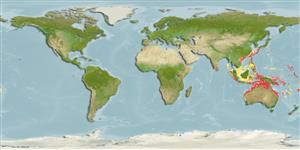Aipysurus duboisii Bavay, 1869
Reef shallows seasnake| Native range | All suitable habitat | Point map | Year 2050 |

|
| This map was computer-generated and has not yet been reviewed. |
| Aipysurus duboisii AquaMaps Data sources: GBIF OBIS |
Google image |
No photo available for this species.
Classification / Names Common names | Synonyms | CoL | ITIS | WoRMS
Reptilia | Squamata | Hydrophiidae
Environment: milieu / climate zone / depth range / distribution range Ecology
Reef-associated; depth range 21 - 80 m (Ref. 2352). Tropical; 51°N - 58°S (Ref. 356)
Distribution Countries | FAO areas | Ecosystems | Occurrences | Introductions
Northeast Atlantic to Western Pacific.
Length at first maturity / Size / Weight / Age
Maturity: Lm 91.0, range 91 - 116.2 cm Max length : 148 cm SVL male/unsexed; (Ref. 2355); common length : 80.0 cm SVL male/unsexed; (Ref. 2355)
Short description Morphology
Life cycle and mating behavior Maturity | Reproduction | Spawning | Eggs | Fecundity | Larvae
Main reference
References | Coordinator | Collaborators
Ineich, I. and P. Laboute 2002 Sea snakes of New Caledonia. IRD Éditions. Institut de Recherche pour le Développement. Muséum national d'histoire naturelle. Collection Faune et flore tropicales. 39:302 pp. (Ref. 2352)
IUCN Red List Status
(Ref. 130435: Version 2025-1)
CITES status (Ref. 108899)
CMS (Ref. 116361)
Threat to humans
Human uses
| FishSource |
Tools
More information
Max. ages / sizes
Length-weight rel.
Length-length rel.
Length-frequencies
Mass conversion
Abundance
Internet sources
BHL | BOLD Systems | CISTI | DiscoverLife | FAO(Publication : search) | Fishipedia | GenBank (genome, nucleotide) | GloBI | Gomexsi | Google Books | Google Scholar | Google | PubMed | Tree of Life | Wikipedia (Go, Search) | Zoological Record


